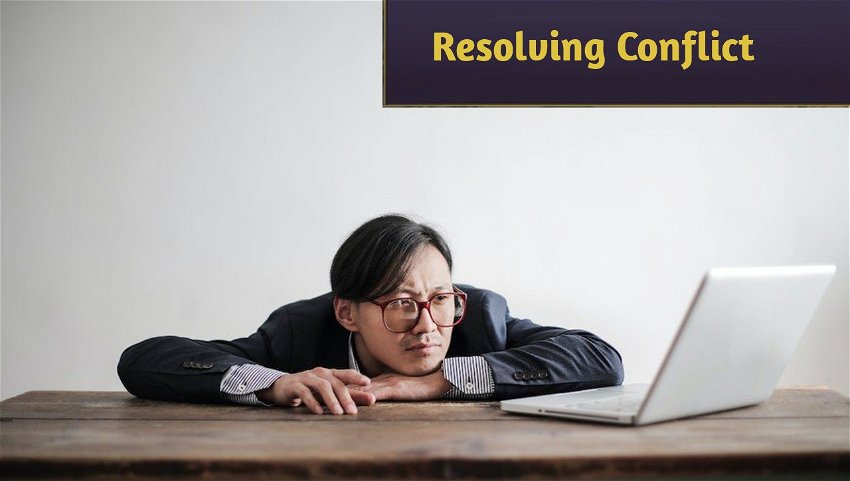The introduction
In today's rapidly-evolving workplaces, high-stress atmospheres have become less the exception and more the rule. We as professionals can expect to regularly be confronted with tight deadlines, demanding clients, and a myriad of conflicting priorities. It is essential that we know how to approach these conflicts without compromising productivity and collaboration. In this piece, I will discuss my own knowledge of conflict resolution as an author as well as other real-life scenarios.
Understanding the Dynamics of Conflict
Any dynamic workplace will always have conflict. Although conflicts can be stressful, they also offer opportunities for growth and understanding if they are managed adeptly. Conflict can result from differences in opinion, misunderstandings, competition for resources, or clashes of personalities.
Communicating Challenges
Miscommunication is often the root of workplace conflicts. Emails can be misinterpreted, instructions can be too vague, and expectations may not be clear, leading to major disputes that arise from minor issues. From my experience, I recall an incident where a lack of understanding around project deadlines caused frustration and recrimination amongst team members. To prevent such occurrences, it's essential to have an atmosphere of open communication; regular check-ins, feedback opportunities and collaboration tools can all help to reduce the possibility of confusion.
Active Listening as a Catalyst for Resolution
Conflict resolution relies heavily on active listening. It is possible to uncover the underlying issues by allowing parties to express their concerns without interruption. I have encountered situations where co-authors' differing viewpoints threatened the quality of our work throughout my writing career. We were able to address concerns and arrive at creative compromises that enhanced our content by facilitating a roundtable discussion where each author felt genuinely heard.
The Role of Emotional Intelligence
The emotions can run high during high-stress scenarios, preventing effective conflict resolution. Emotional intelligence (EI) is crucial in this situation. EI involves recognizing and managing emotions in oneself as well as others. For example, I disagreed with my editor about the direction of an article as an author. Understanding her perspective and approaching the situation with empathy allowed me to present my viewpoint more persuasively, leading to a successful outcome.
Expert Insights from CMA Consulting
CMA Consulting, a renowned authority in conflict resolution science, emphasizes the importance of adopting a structured approach to conflict resolution. It has been proven to de-escalate tensions and promote collaboration even in high-stress environments by identifying common goals, acknowledging individual contributions, and focusing on shared interests.
Collaborative Problem-Solving
In order to resolve conflicts effectively, collaborative problem-solving is one of the most effective methods. Instead of looking at the conflict as a win-loss scenario, this approach seeks to find solutions for all parties involved. As an example, we adopted a collaborative approach during a conflict over resource allocation on a project. As a result of analyzing each team member's needs and brainstorming collectively, we devised a plan that maximized resource utilization and satisfied everyone.
Mediation and Third-Party Intervention
It is sometimes impossible to resolve conflicts directly through direct communication alone. This is where mediation and third-party intervention come in. In my writing journey, we invited an unbiased colleague to mediate when co-authors disagreed on which sections should be included. By facilitating constructive discussions, the mediator assisted us in reaching a consensus that balanced diverse viewpoints.
The Power of Reflection for Learning and Growth
Every conflict presents an opportunity for learning and growth. Reflecting on the causes of conflicts, the strategies employed, and the outcomes achieved can provide valuable insights for the future. In my writing collaborations, revisiting past conflicts has helped me refine my communication and negotiation skills, contributing to smoother teamwork in subsequent projects.
Conclusion
In the busy and chaotic workplace, conflict is a fact of life. Yet how we handle these issues can be crucial. Through engaging communication, attentive hearing, emotional intelligence, joined-up problem-solving and professional counselling when necessary, conflicts can become opportunities for growth. As we work our way through this intricate path of conflict resolution, let us remember CMA Consulting's wise words: that a well-planned and shared approach will steer us towards solutions even in trying times.
Frequently Asked Questions
In high-stress work environments, why is conflict resolution important?
When working in high-stress environments, conflict resolution is essential to maintaining a harmonious atmosphere, promoting productivity, and encouraging innovation. Conflicts that go unresolved can undermine morale, hinder teamwork, and compromise performance.
In the workplace, what are the most common sources of conflict?
In high-stress situations, conflicts can escalate quickly due to differences in opinions, misunderstandings, competition for resources, clashing personalities, and unclear expectations.
What is the impact of communication on conflict resolution?
Miscommunication, lack of clarity, or vague instructions can escalate minor issues. Creating an environment of open communication, regular check-ins, and feedback mechanisms can prevent misunderstandings.
In what ways does active listening contribute to conflict resolution?
By actively listening, parties can express their concerns and uncover underlying issues. Active listening promotes understanding and empathy, which are essential for resolving conflicts.
How does emotional intelligence (EI) contribute to conflict resolution?
The ability to recognize and manage one's own and others' emotions is essential in high-stress situations to deal with conflicts with empathy, understanding, and persuasiveness.
In conflict resolution, how can collaborative problem-solving be effective?
The goal of collaborative problem-solving is to find solutions that benefit all parties. By switching from a win-lose mindset to a cooperative perspective, conflicts can be resolved in a way that meets the diverse needs of everyone involved.
What is the best time to consider mediation or third-party intervention?
Whenever conflict is complex and direct communication is insufficient, a neutral mediator can facilitate discussions and help parties reach a consensus.
In high-stress work environments, what can we learn from conflicts?
In order to improve communication, negotiation skills, and conflict resolution techniques, it is important to reflect on the causes, strategies, and outcomes of conflicts.
How can expert insights, such as those from CMA Consulting, facilitate conflict resolution?
Conflict resolution experts provide structured approaches and evidence-based strategies that emphasize identifying common goals, acknowledging individual contributions, and focusing on shared interests.
In high-stress environments, what is the key takeaway for resolving conflicts?
Communication, active listening, emotional intelligence, and a collaborative problem-solving mindset are essential to resolving conflicts in high-stress work environments. Conflicts can contribute to professional and personal growth when they are handled with the right strategies. When approached with the right strategies, they can be transformed into stepping stones for development.










— 评论 0
, 反应 1
成为第一个发表评论的人